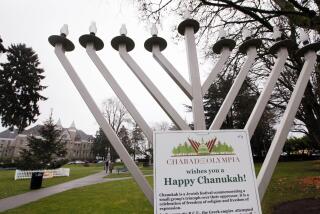Mezuzas Finding Place Throughout Jewish Households
Once a mezuza in every room was a sure sign of an observant Jewish household. The less religious usually hung a single mezuza -- a tiny scroll of Hebrew scripture in a protective case -- on the right side of the front door.
But today, even Jews who don’t keep kosher are filling their houses with mezuzas. It is a trend that reflects a distinctly Jewish twist on the desire to make every home a refuge, observers say, and a new variety in mezuza covers, which now feature clowns and ballet shoes as well as scenes of Jerusalem and stars of David.
Carol Sales began putting mezuzas throughout her house more than a decade ago. Until then, Sales, an administrator and accountant at Temple Akiba, a Reform synagogue in Culver City, had only one mezuza: the one by her front door.
“My uncle is a rabbi in Venice, and going there on Shabbat, I’d see the mezuzas on all the doors, and I would think, ‘What is this? Isn’t one good enough?’ ”
Then, about 15 years ago, a Christian friend brought Sales a mezuza salvaged from a shop on Pico Boulevard that was being remodeled by a new, non-Jewish owner. Sales hung the mezuza on the door to her bedroom and she has since added two more to her home.
“What’s really neat is now they have so many styles -- for little girls, for little boys,” said Sales, who put a mezuza with a pink cover on the bedroom used by her 11-year-old granddaughter, Tayler.
Rabbi Stephen Robbins, who founded the Academy for Jewish Religion, California, a trans-denominational rabbinical and cantorial school on the Westside, has noticed a growing interest in mezuzas among Jews of all denominations.
“People want them increasingly because it’s a Jewish practice of blessing, cleansing, healing, ordering, and turning the home into a sacred space,” said Robbins, who also is the rabbi at Temple N’Vay Shalom in Los Angeles. Affixing a mezuza is part of a wider “return to spirituality,” he said.
Robbins said he teaches his rabbinical students to go through a house, room by room, praying and exploring the spiritual meaning of the room before hanging each mezuza. In a nursery, the parents and others express their hopes that the child who sleeps there will be safe and happy, and that it will be a place to play, learn and grow.
The mezuza featured in this 21st century ritual is grounded in 3,000 years of tradition. One of the two brief sections of the Torah on every mezuza scroll is the verses in Deuteronomy commanding Jews to put God’s word on their gates and doorposts. Many believe those who perform the mitzvah, or religious obligation, receive God’s protection. It is customary to touch the mezuza and put those fingers to one’s lips.
The mitzvah of mezuza must be done precisely if it is to fulfill the commandment, said Aaron Shaffler, a Chasidic rabbi with a shop in Beverlywood called Mezuzah Gallery. Shaffler often starts conversations with customers who are not Orthodox by explaining that the mezuza is the parchment scroll bearing the Torah words, not its decorative case.
And Shaffler warns that a machine-copied mezuza or one that isn’t written by an observant Jew in black ink on parchment made from a kosher animal does not fulfill Jewish law.
A rabbi, merchant and father of four, Shaffler also is a sofer -- a scribe trained to write, check and fix Torah scrolls, mezuzas and other holy objects.
As Shaffler explains, every mezuza scroll includes the shema, the traditional Jewish declaration of faith in one God. A mezuza’s 713 Hebrew letters must be written in order, and the whole process begins with a prayer, said loud enough for the sofer to hear.
Shaffler likes to write with a pen he makes from a turkey quill (such pens are scorned by one Jewish sect, whose rebbe ruled that the turkey, unlike the chicken, is not kosher). Other soferim prefer pens cut from a reed, a reminder of the Torah story of the finding of the infant Moses in bulrushes. Metal pens are permitted.
Hundreds of rules govern the creation, hanging and care of mezuzas, and Shaffler knows them all. He counsels customers to hang one at the entrance of every room that has a doorway and is larger than 4 cubits (about 6 1/2 feet) by 4 cubits.
He cautions against putting the scroll in a transparent container at the entrance to a couple’s bedroom or a place where dirty diapers will be exposed. Because the name of God appears on the outside of the rolled scroll, he explained, “You don’t want it to be anywhere that would be disrespectful.”
David Cooperman said mezuzas are among the most popular items at Shalom House, his family’s Judaica store in Woodland Hills. At home, most of his many mezuzas were made by the artists whose work he carries. A fused-glass-and-copper cover by Gary Rosenthal is on the front door. Ben-Zion David made the silver-and-lapis cover of the kitchen mezuza.
And Mordechai Hazan, a popular artist who moved to Israel several years ago from the San Fernando Valley, made the mezuza covers for the bedrooms his five daughters share. The covers feature their favorite animals, including a rain forest full of frogs, a panda, and a Noah’s ark with a pair of giraffes.
Because the scroll is the soul of the mezuza, “the sky’s the limit” for the case, Cooperman said. No nudes, of course, or other violations of Jewish law.
But Cooperman stocks covers to appeal to ballerinas, poker players, dentists, cowboys, newlyweds, soccer players and police officers -- the last featuring a gun, badge and handcuffs. He once had a Harley-Davidson case made for a woman who loves to ride; a man who collects anything with a turkey on it bought a gobbler mezuza cover.
Simple plastic cases cost a few dollars -- bejeweled ones, many hundreds. And covers of Jerusalem stone are always popular, Cooperman said.
Fay Miller hung a mezuza on her front door 28 years ago after she bought her Calabasas home. The original is still there, its metal case now slightly corroded. Miller owns Shardz, a company that turns the glasses ritually shattered by Jewish bridegrooms into mezuzas and other religious objects.
A self-described “middle-of-the-road” Jew, Miller recently had one of her artisans make a transparent mezuza case that she placed on the doorway to her kitchen because, she said, “I love my kitchen.”
Her most observant friends hang mezuzas next to all their doors, except those that lead to bathrooms, where tradition forbids it. And almost all the Jews that Miller knows buy a mezuza case decorated with ABCs or teddy bears when a baby is born.
Musician Robby Helperin has 13 mezuzas in his Beverlywood home, including four in the studio devoted to his klezmer orchestra, Simcah. The mezuza cover on his young son’s door is Hazan’s popular Noah’s ark. His daughter’s is “something pink and pretty.”
As an observant Jew, Helperin says the blessing for each new mezuza and attaches it according to Jewish law. He touches the mezuza reverently each time he enters the room, then puts his fingers to his lips.
For Helperin, the mezuza is a treasured aspect of how “Judaism takes life and makes poetry out of it.”


